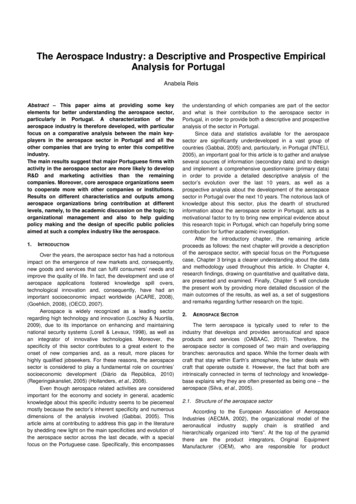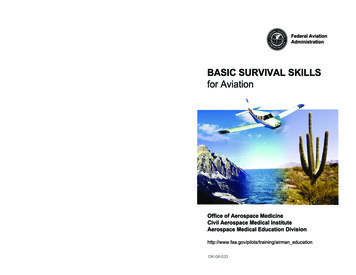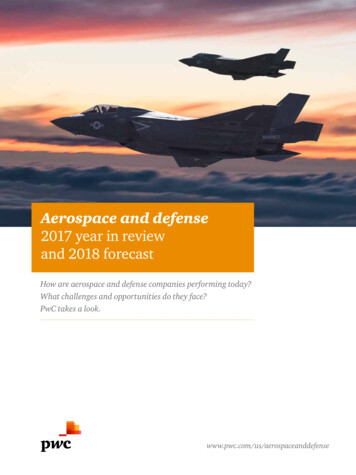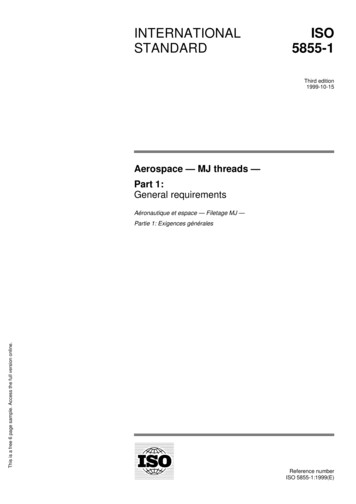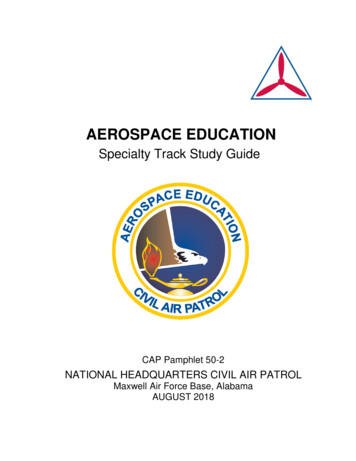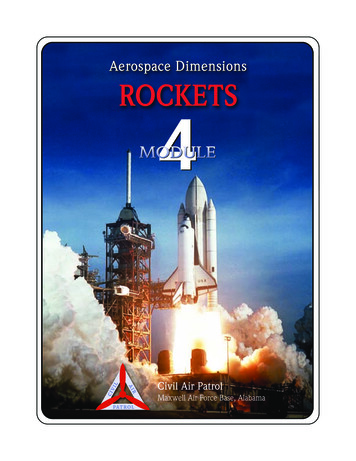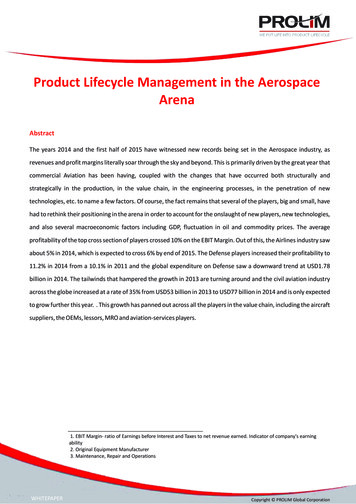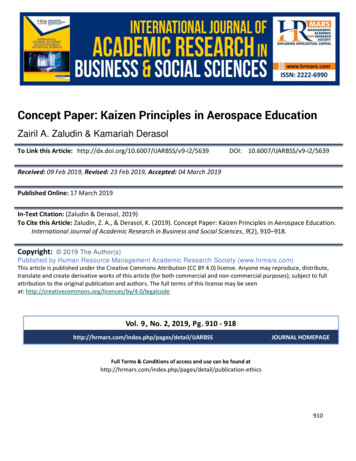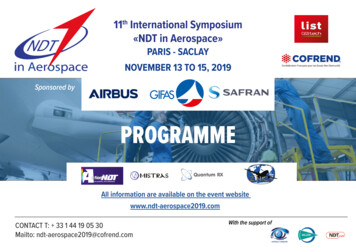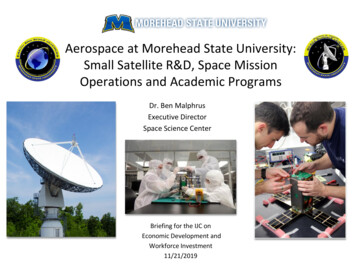
Transcription
Aerospace at Morehead State University:Small Satellite R&D, Space MissionOperations and Academic ProgramsDr. Ben MalphrusExecutive DirectorSpace Science CenterBriefing for the IJC onEconomic Development andWorkforce Investment11/21/2019
Kentucky is an Aerospace StateThe aerospace/aviation footprint is expanding in Kentucky in almost every sector from partsmanufacturing to supply, from air freight service to education and workforce development. Severalfactors contribute to the intense interest in Kentucky, chiefly a highly skilled and experiencedworkforce, excellent infrastructure and location.AEROSPACE EXPORTS: KY’s #1 Manufactured Export isAerospace Aerospace exports have increased 183%in the past five years.AEROSPACE EXPORTS: According to the U.S. Census Bureau,Kentucky ranked 2nd in the country ininternational exports of AerospaceProduct and Parts in 2018, valued at 12.56 billion, 14 billion in 2019https://www.thinkkentucky.com/Existing Industries/Aerospace.aspx
Aerospace in the CommonwealthAEROSPACE EMPLOYMENTIn total, the cluster supports close to21,000 jobs and 1.46 billion in wages.There are approximately 9,300 peopledirectly employed in the cluster, but theeconomic activity it generates supportsadditional jobs.AEROSPACE EMPLOYEE INCREASE:Kentucky has seen a 63 percent employeeincrease in the private aerospace productsand parts manufacturing industry since 200
Morehead State and Aerospace- the Space Sideof AerospaceBy 2005, Kris Kimel (KSTC) envisioned KYbecoming a world leader in spacetechnologies Morehead State’s Space Science Center has become Internationally Recognized asa Center for Excellence in Small Satellite Technologies and Space MissionOperationsMorehead State has flown 6 small satellite missions with 4 in DevelopmentMorehead is the home of the inventor of the CubeSat satelliteMorehead Currently has 7 NASA ContractsAerospace Workforce Pipeline is in Place Space-Related Degree Programs at Morehead State University– First Engineering Program in Eastern Kentucky– Only Aerospace Engineering CIP Code Degrees in Kentucky Space-Trek, Space Prep, Go for Launch, Craft Academy
Morehead State University Academic Programs Provide: Undergraduate Research Experiences Instrumentation Experience Engineering Design Observational Astrophysics Research Ground Ops (TT&C) Project Management Experience Systems-level Engineering Experience
Kentucky’s Best Assets for the Aerospace IndustryKentucky’s Most Important Employers in the Aerospace IndustryAlso receiving votes: BAE; Belcan; DHL; Prime Air; Meggitt; Phoenix Products; Space Tango.The Best in Aerospace R&D in KentuckyMorehead State UniversityUniversity of LouisvilleEastern Kentucky UniversityKentucky State University.Kentucky’s Best Colleges forAerospaceWorker TrainingMorehead State UniversityUniversity of LouisvilleEastern Kentucky UniversityBest Sites in Kentucky for Large Aerospace AssemblyBest Places in North Kentucky for Aerospace CompaniesBest Places in West Kentucky for Aerospace Companies
Aerospace Degree Programs: B.S. in Space Science B.S. in Physics Area Astrophysics M.S. in Space Systems EngineeringProgram Highlights: B.S. in Space Science has ca. 100% Job PlacementExtreme Hands-On ExperiencesStudents Work on Actual Space MissionsStudents Develop Skillsets in: Space Systems Development and OperationMechanical Systems Design and CADElectronics- Electrical EngineeringMicroelectronicsCoding and Software Systems DevelopmentSpace PhysicsSpace Mission Architecture and OperationsFor additional information:http://www.moreheadstate.edu/ssc/Tel: (606) 783 2381
B.S. in Space Science Currently a Hybrid Science-Astronautical Engineering Program One of Only 5 Similar Undergraduate Programs in the U.S. Transitioning into B.S. in Space Systems Engineering(Astronautical Engineering) Fall 2019Program Highlights: Student Population in theB.S. in Space ScienceProgram103104120 1348039455862 For additional information:B.S. in Space Science has Nearly 100%Job Placement40% of the Students are FemaleExtreme Hands-On ExperiencesStudents Work on Actual Space MissionsStudents Develop Skillsets in:Space Systems Development and OperationMechanical Systems Design and CADElectronics- Electrical EngineeringMicroelectronicsCoding and Software Systems DevelopmentSpace PhysicsSpace Mission Architecture and OperationsExperience Significant GrowthPoised for Expansionhttp://www.moreheadstate.edu/ssc/Tel: (606) 783 2381
M.S. in Space Systems Engineering Established in 2014First Engineering Program in Eastern KentuckyProduces Design-level EngineersAttracts Traditional and Non-Traditional StudentsProgram Highlights: Student Population in theM.S. in Space SystemsEngineering Program171018191162014-152015-162016-172017-18 2018-2019 2019-2020For additional information:M.S. in Space Systems Engineering hasApproximately 100% Job Placement80% of the Students are from U.S.*Extreme Hands-On ExperiencesStudents Work on Actual Space MissionsStudents Develop Skillsets in: Space Systems Development and Operation Space Systems Design Electronics- Electrical Engineering Microelectronics Software Systems Development Program Management Space Mission Architecture and Operations* ITAR and EAR Considerations Restrict the number of InternationalStudents to NATO Countrieshttp://www.moreheadstate.edu/ssc/Tel: (606) 783 2381
B.S. and M.S. in Space Systems EngineeringWhere Students Originate and Where They GoWorkforce Placement- MoreheadState Graduates are Employed by:Origins- Morehead State StudentsOriginate from:Undergraduate:80% from Kentucky20% from Other States:Ohio, WV, NY, CAGraduate:85% from U.S.15% International:Italy, England, Korea, Viet Nam,Ukraine, Russia**Morehead State’s ITAR Compliance Policy restricts theinternational students and the projects that they canbe involved with/exposed toFor additional information: JPL NASA Johnson Space Center NASA Glenn Research Center Air Force Institute of Technology Rajant Corporation Space Micro, Inc Space Dynamics Laboratory Tyvak Lockheed Martin ViaSat Honeywell Aerotek Terran OrbitalAccepted into Ph.D. Programs at: MIT, Cornell, Purdue, GA Tech, Universityof Michiganhttp://www.moreheadstate.edu/ssc/Tel: (606) 783 2381
NANOSATELLITE TECHNOLOGIESATMOREHEAD STATE UNIVERSITYLeading the Space Segment of Aerospacein Research and DevelopmentAnd Workforce Training
:The Next Big Thing is Small Projections indicate substantial growth, with anestimated 500 nano/microsatellites launchedglobally by 2020Constellations of Small Sats Used for:––––––––Data TransferFinancial TransactionsHomeland DefenseTactical SecurityGPSNavigation, AISEarth Remote Sensing (with un-precedented refreshrates)Inventory from Space
:Small Size, Big Capability Constellations of SmallSats Used for:–––––––––Data TransferDM-7 DesignedFinancial Transactionsand Built byMoreheadHomeland DefenseState andHoneywellTactical SecuritySpace andDefenseAsset TrackingTechnologiesInternet DeliveryEarth Remote Sensing (with un-precedented refresh rates)Data Exfiltration from Unattended Ground SensorsInterplanetary Research
SmallSat MarketSmallSat Market Smallsat market forecast toexceed 30 billion in comingdecade- SpaceNews August9, 2017 The small satellite marketwas valued at 3,632.4million in 2018, and isexpected to reach 15,686.3million by 2026, AlliedMarket Research 2019 SmallSat market requires adifferent operational modelthan large monolithic GEOconstellationsCST’s alliance with strategic partners fills a significant market nichewhen mobilized in the window of opportunity10/21/2019Centaurus Space Technologies
Morehead State SmallSat Missions KySat-1Secondaryon NASA’s GloryMission 6 Satellites Launched1U,2U,3U CubeSatsMicrosat SubsystemsPocketQubs6U Bus in DevelopmentInterplanetary MissionVariety of CustomersCXBN Launched in 2012Lunar IceCube is a CubeSat mission designed to prospect for water iceother lunar volatiles from lunar orbit. The mission was selectedunder NASA's NextSTEP to fly on EM-1. Lunar IceCube is led byMorehead State and includes partners NASA GSFC, JPL, Busek, andVermont TechKySat-2 Launched inOctober 2013TechSat-1 In Developed for SMDC (w/Radiance and Honeywell)UniSat-5 w/ Univ. ofRoma-GAUSS launched2014Standard MSU 3-U BusT-LogoQube (Eagle-1)Launched in October2013CXBN-2 Launched in 2016
– Government NASA- JPL, GSFC Department of Defense– DARPA, Space and Missile Defense Command– Universities & Consortia University of Rome Stanford and Calpoly Johns Hopkins APL Craft Academy MIT– Aerospace and Related Companies Honeywell Space and Defense Radiance Busek GAUSS Kosmotras Space Tango Rajant MEDO
Morehead State University SpaceScience Center PartnershipsPartnerships withGovernment,Universities, and thePrivate Sector
Space Science Infrastructure at Morehead State 15.4 M Facility Devoted to SpaceResearch and Development Small Spacecraft Designed, Built, TestedEntirely in House On-Orbit Operations with 21 M SpaceTracking Antenna Infrastructure Development Supported by:–State of Kentucky–Federal Appropriations–Morehead State–NASA–KSTC–US DoD–MSU Foundation–Alumni/ Donors–Faculty-Staff–Grants–Service ContractsMorehead State University Space Science Center
Lunar IceCube Winner of NASA’s NEXTStepContractNASA Lunar Mission Led byMorehead State 24M MissionLaunches on the MaidenVoyage of SLS in 2020- themost powerful rocket everbuiltFront Page News- NASAWebsite on11/14/2019
Lunar IceCube Selected for Launch on Artemis 1 in 2020Currently Under Development atMorehead StateNASA GSFCJPLBusekNASA IV&VClark etal ISmallSat 2015 IceCube20
Lunar IceCubeProject TeamA small scale ( 24M USD) interplanetary missionundertaken by a small teamThe Team consists of university, NASA,and private sector partners: Morehead State University Space Science Center– Ben Malphrus (PI), Jeff Kruth, Kevin Brown, Michael Combs, Jose Garcia,– 48 Students (24 Graduate Students and 24 Undergraduate Students)– 40% of Student Team is Female The Busek Company– Mike Tsay, John Frongillo, Josh Model NASA Goddard Spaceflight Center– BIRCHES Team: Clifford Brambora, Terry Hurford, Robert MacDowall– Navigation and Tracking: David Folta, Sun Huir-Diaz– Attitude Control: Paul Mason, Robert Nakamura, Joseph Breeden– FSW: Justin Morris, Matt Grubb, Scott Zemerick, Cody Cutright NASA JPL– Pamela Clark (Science PI), Kris Angkasa, Vaughn Cable, AlessandraBabuscia11/21/201921
Lunar IceCubeProject OverviewMission Description and ObjectivesLunar IceCube is a 6U small satellite whose mission is to prospect forwater in ice, liquid, and vapor forms and other lunar volatiles from alow-perigee, inclined lunar orbit using NASA GSFC’s BIRCHES - IRspectrometer. 1.) Lunar IceCube will be deployed by the SLS on EM-1and 2.) use an innovative RF Ion engine combined with a low energytrajectory to achieve lunar capture and a science orbit of 100 kmperilune.Strategic Knowledge Gaps1-D Polar Resources 7: Temporal Variability and Movement Dynamicsof Surface-Correlated OH and H2O deposits toward PSR retention1-D Polar Resources 6: Composition, Form and Distribution of PolarVolatiles1-C Regolith 2: Quality/quantity/distribution/form of H species and othervolatiles in mare and highlands regolith (on the final inclination of theLunar IceCube orbit)Technology Demonstrations Busek BIT 3 - High isp RF Ion Engine – NASA GSFC - BIRCHES Miniaturized IR Spectrometer - characterizewater and other volatiles with high spectral resolution (5 nm) andwavelength range (1 to 4 μm) Space Micro C&DH- Inexpensive Radiation-tolerant Subsystem JPL Iris v. 2.1 Ranging Transceiver BCT- XACT ADCS w/ Star Tracker and Reaction Wheels Custom Pumpkin- High Power (120W) CubeSat Solar ArrayCritical MilestonesCurrent Status Team is in AI&T, Delivery of final Flight Hardware anticipated inNovember Dry Build Underway Preparing for Flight Build and Comprehensive Performance Testing FSW in testing ACS Model Refined, Closed-Loop Control in Development Working Toward Closing Phase III Safety SVTLs (5/6 are Closed) FRR Scheduled for 03/21/202022PDRPhase 1CDR/05/19/201606/20/201605/16/1711/21/2019 from AES EOY 2019 CDRPhase 2Phase 3FRRLaunchMission OpsMission DurationProject Closure03/14/1804/26/201805/23/201903/21/2020NOV 20202020-20222 years incl. ext.2022-23
Lunar IceCubeProject OverviewTechnology Demonstrations Busek BIT 3 - High isp RF Ion Engine – NASA GSFC - BIRCHES Miniaturized IR Spectrometer characterize water and other volatiles with high spectralresolution (5 nm) and wavelength range (1 to 4 μm) Use of Analytic tools to Define Low Energy ManifoldTrajectory for Lunar Trajectory and Capture Space Micro C&DH- Inexpensive Radiation-tolerantSubsystem JPL Iris v. 2.1 Ranging Transceiver BCT- XACT ADCS w/ Star Tracker and Reaction Wheels Custom Pumpkin- High Power (120W) CubeSat SolarArray2311/21/2019
Lunar IceCubeHardware Developments to DateFlatSat- Current ConfigurationProto-Dry Build View Y Axis UpFlatSat- Current ConfigurationProto-Dry Build View Y Axis UpL-IC BIT-3 FM at BusekProto-Dry Build View Y Axis UpBIT-3 Propulsion System QMFlatSat- Configuration 1.0 with Labels11/21/2019 from AES EOY 2019BIRCHES IR SpectrometerBIRCHES IRSpectrometerBIT-3 Thruster and Neutralizer Hot Firingwith IodinePropellantSystem FMBIT-3 Propulsion25
Enabling University-Operated Tracking andCommunications for Deep Space SmallsatMissionsFunded by NASA’s Advanced Exploration Systems (AES)Ben Malphrus, Jeff Kruth (MSU)Tim Pham, Jay Wyatt, (JPL)In Partnership with
DSN Affiliated Ground Station (DSS-17) forInterplanetary SmallSats- Morehead State 21 mProject Description and ObjectivesDemonstrate a cost-effective process for expanding DSNcapabilities by utilizing non-NASA assets to provide communicationand navigation services to small spacecraft missions to the Moonand inner solar system, thereby enabling interplanetary researchwith small spacecraft platforms.Technical Approach Develop and implement a strategy to transfer Deep Space Network (DSN)processes and protocols to the MSU 21 m antenna system to enableintegration into the DSN as an auxiliary station to support small spacecraftmissions. Implement deep space communications, tracking and navigation techniquesas well as adoption of CCSDS standards. Implement systems upgrades, conduct tests/demonstrations, and transition toan operational capability.BenefitsCurrent Status Serves as a test-case for other non-NASA ground stations to provide auxiliarydeep space navigation and tracking support for small spacecraft missions. Develops an operational capability to support EM-1 CubeSat missions in the2019 timeframe DSN “Lite” System Defined and inDevelopment/Procurement H-MASER Procured Cryogenic X-Band LNA Procured X-Band Feed in DevelopmentCritical MilestonesΔSRRIoNetConnection01/15/2016 gingDemoORROperational Mission Ops Mission Duration Project Closure5/15/2017 02/15/2019 5/15/2018 10/30/2019 10/15/2019FY17 - AES Mid-Year1/1/2020EM-1 CubeSatsDurationEM-1 CubeSatsClosure27
Morehead State University21 Meter Space Tracking Antenna Specifications by MSU faculty with NASA assistance Dual Purpose Instrument Ground Station for Smallsats Radio Telescope for Astronomy Research Funded 6 M -a variety of sources- Morehead State, Federal and State Funds, KSTC, NASA Built and Installed by VertexRSI (General Dynamics) Operational in 2006
The Morehead State University Ground Station Quiet RFI Environment in Eastern Kentucky (Southeastern US) 21 m Ground Station (few in the US large enough for DSN Work) Staff Experienced in Mission Operations Experienced RF and Telecom Engineers and Scientists Talented, Intrepid Students
NASA’s DEEP SPACE NETWORK (DSN)Goldstone, CaliforniaJPL, MonroviaNetwork Opera ons ControlCenter (NOCC), DTF-21 Morehead State Univ.Madrid, SpainCanberra, AustraliaJPL, PasadenaDeep Space Opera ons Center(DSOC)MSU 21 M will become the first non-NASA asset on the DSNNASA investing 650K in 21 M UpgradesFY15Planning, SystemsEngineeringFY16Systems Upgrades,ImplementationFY17Downlink and ionto Mission SupportFY19Operational Capability
Private Sector Partnership- RegionalEconomic Development Initiatives Business Incubator Partnership- Innovation Launch Pad Spin-Offs Morehead Electronics and Space Technologies Centaurus Space Systems K-MEC AstroDev Graduate’s Companies Labyrinth Inc. Bamboo RF Affiliated Companies/Partnerships Rajant Technologies Honeywell Space and Defense GAUSS Busek Inc. RoccorFor additional information:http://www.moreheadstate.edu/ssc/Tel: (606) 783 2381
Private Sector Partnership- A Case StudyRajant Technologies Rajant- Pioneer of Kinetic Wireless Mesh Technologies HQ in Philadelphia, U.S. Partner on Tech Development, Contracts, Grants Located R&D Subsidiary in Morehead, KY Hired Nearly 30 Graduates to Date 23 Work at Morehead Location Utilize Space Science Center StaffTalent Facilities Undertake Joint Talent RecruitmentEfforts Effective Symbiotic Relationship11/21/201932
11/21/201933
InstaMesh to be Expanded to Constellations- SpaceMeshRajant, CST and Morehead State areworking toward adapting the InstaMeshtechnology for inter-satellite constellations Inter-satellite comms, whenaccomplished, is a game-changer Turns groups of satellites into trueconstellations Tremendously improves:o Data throughputo Latencyo Ground network optimization Allows the use of DTN- disruptiontolerant networking34
In Conclusion Kentucky has (quietly) become anAerospace-based Economy Many opportunities for YoungKentuckians to join the aerospaceindustry, related R&D and relatedtechnology innovation Morehead State’s Lunar IceCube willbe on the Maiden Voyage to the Moonof the Most Powerful Rocket Ever Built We are entering a new era of SpaceExploration with Small SatellitePlatforms- Artemis 1 andConstellations: Morehead is at theForefrontMorehead State University Space Science Center
Questions?
Back-Up
NASA Videohttps://www.youtube.com/watch?v OZvDAAI JM0&feature youtu.be
The Team consists of university, NASA, and private sector partners: Morehead State University Space Science Center -Ben Malphrus (PI), Jeff Kruth, Kevin Brown, Michael Combs, Jose Garcia, -48 Students (24 Graduate Students and 24 Undergraduate Students) -40% of Student Team is Female The Busek Company -Mike Tsay, John Frongillo .
